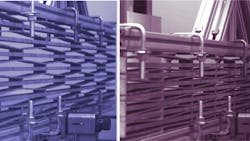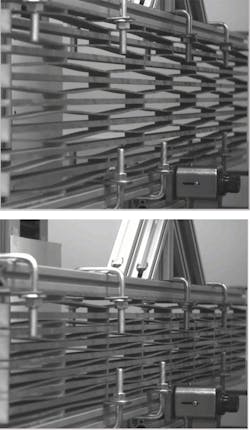Ready for Takeoff: 3D Printing a Portable Runway Mat
At a Glance:
- When PXCMs deform, the material is fully recoverable and can be reused to absorb and dissipate energy multiple times.
- A Purdue University researcher hopes PXCM-based properties will bolster the material’s candidacy as a replacement for AM-2 portable runway matting.
- The runway mats will be 3D printed with help from Indiana-based ITAMCO.
The idea of a shape-shifting, self-healing runway strip that’s easy to install and store sounds farfetched. Should the design of new 3D-printed roll technology pass muster, however, the concept will be not only attainable, but also the preferred option.
Solicitation from the U.S. Department of Defense Airport for solutions for runway mats that were lightweight, convenient and durable spurred Pablo Zavattieri, the Jerry M. and Lynda T. Engelhardt Professor in civil engineering at Purdue University, to propose a new material he’d been developing as a candidate solution that could also address issues associated with buckling in landing mats.
Traditional portable airfield runways play an essential role in propelling U.S. Air Force missions. The AM-2, a portable runway surface constructed from aluminum plank matting, has been in service since the Vietnam War.
A novel use of materials known as phase transforming cellular material (PXCM) geometry could be a viable alternative to the AM-2, according to Zavattieri, who is collaborating with Indiana-based ITAMCO (Indiana Technology and Manufacturing Companies) on the project. “Products made with PXCM geometry have the ability to change from one stable configuration to another stable or metastable configuration and back again,” he said.
Self-healing Properties
The PXCM runway mat solution is comprised of an upper surface that mates with a lower surface to form a stable configuration, Zavattieri explained, adding that the mats can flex back and forth while still remaining stable. He described his current research as the interface between solid mechanics and materials engineering.
Zavattieri first started researching the material while working with General Motors. In a paper published in 2015 in the journal Extreme Mechanics Letters, he and his co-authors describe how PXCMs have the ability to absorb energy at various lengths and scales.
The material is reusable because the material’s phase transformation is reversible and does not alter or deform the base material, explained Zavattieri. “This means the new runway mat could potentially ‘heal’ itself, resulting in a much longer lifespan than a runway made with AM-2 matting,” he said.
A $1 million Small Business Innovation Research Phase II grant from the U.S. Air Force is helping to fast-track the development of the 3D-printed runway mat. Prototypes of the mat will be printed on ITAMCO’s EOS M290 additive manufacturing printer. Zavattieri noted that his team will be able to evaluate the product’s reliability, including whether the prototype can maintain its shape and its operational capability 30 minutes following compaction.
According to ITAMCO, the PXCM runway material offers further benefits: It can be laid by hand, is targeted to weigh 3.5 lb per sq. ft. or less, and will support flight operations of 5,000 landing and takeoff cycles over 60 days.
Further Applications
Since PXCMs have the flexibility to be configured to be bi-stable or metastable, the material can be used in multiple applications, said Zavattieri. “You might need PXCMs with metastable unit cells for head protection in helmets, but then maybe you would need materials with bi-stable unit cells for buildings to protect against earthquakes,” he explained.
Zavattieri also envisions using the materials in the construction of automotive components, such as bumpers or no-pneumatic tires.
About the Author

Rehana Begg
Editor-in-Chief, Machine Design
As Machine Design’s content lead, Rehana Begg is tasked with elevating the voice of the design and multi-disciplinary engineer in the face of digital transformation and engineering innovation. Begg has more than 24 years of editorial experience and has spent the past decade in the trenches of industrial manufacturing, focusing on new technologies, manufacturing innovation and business. Her B2B career has taken her from corporate boardrooms to plant floors and underground mining stopes, covering everything from automation & IIoT, robotics, mechanical design and additive manufacturing to plant operations, maintenance, reliability and continuous improvement. Begg holds an MBA, a Master of Journalism degree, and a BA (Hons.) in Political Science. She is committed to lifelong learning and feeds her passion for innovation in publishing, transparent science and clear communication by attending relevant conferences and seminars/workshops.
Follow Rehana Begg via the following social media handles:
X: @rehanabegg
LinkedIn: @rehanabegg and @MachineDesign


